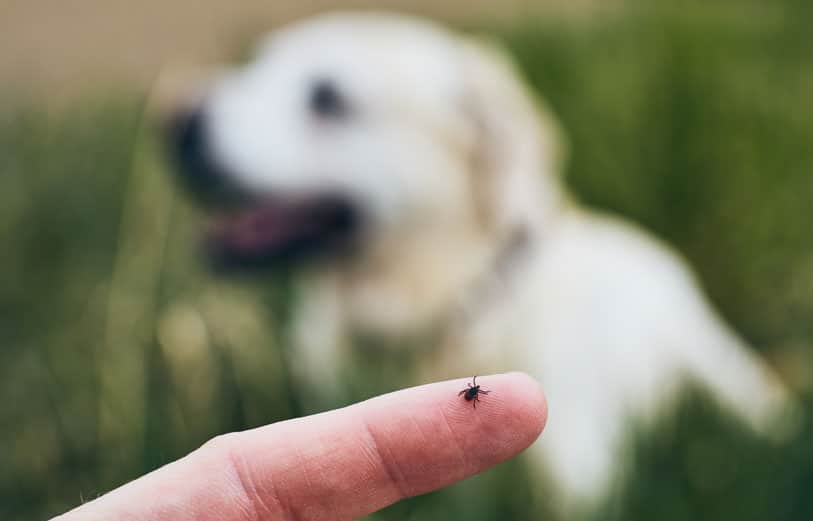Tick Season: What You Need to Know

It’s tick season in Illinois—Protect yourself and your loved ones from tick bites.
Tick season is approaching.
When warmer weather arrives, nearly everyone welcomes the opportunity to go outside. Unfortunately, ticks also become active. The following information will help you recognize ticks, know where they live, and understand how to protect yourself and your loved ones from tick bites.
What is a tick?
Ticks are small parasitic arachnids that belong to the same family as spiders. Due to their small size and eight legs, ticks are often difficult to see and can be mistaken for spiders.
Unlike their web-spinning cousins, ticks do not craft intricate webs. Instead, they rely on their unique ability to latch onto hosts and feed on their blood.
Where do ticks live?
Ticks thrive in environments with tall grass, shrubs, and leaf litter. They can also live in your yard and on your pets.
Outdoor activities such as camping, hiking, and even walking your furry companion can inadvertently expose you (and your pets) to these tiny parasites.
Tick exposure can occur year-round, but is most likely during warmer months when ticks are active (April – September.)
What do ticks eat?
Unlike spiders, which feast on insects, ticks sustain themselves by extracting blood from their hosts. Remarkably, tick bites are typically painless, and they often go unnoticed until the tick has filled and “swelled.”
Can a tick bite make you sick?
Yes, indeed. Tick bites can result in various illnesses. Fortunately, there are proactive measures you can take to mitigate your risk of tick-borne illness.
Keep ticks at bay.
Prevention is paramount when it comes to tick bites. The following precautions are proven effective barriers against ticks:
- Use insect repellants containing DEET when venturing outdoors.
- Avoid wooded areas and dense foliage where ticks thrive.
- Wear a long-sleeved shirt and long pants.
- Tuck your pant legs into your socks.
Upon returning indoors, promptly shower to remove unattached ticks. Enlist a trusted individual to help inspect your body for ticks.
Where to check for ticks:
- In and around the hair and ears.
- Under the arms and in body folds (elbows, back of knees, groin, etc.).
- Inside the belly button.
- Around the waist.
Remove ticks immediately.
Ticks can spread disease within hours to days after attaching to a host. Immediate action is crucial when a tick has latched onto your skin.
- Use tweezers to gently grasp the tick as close to the skin's surface as possible.
- Steadily pull the tick away until it is removed from your skin.
- Following removal, cleanse the bite area thoroughly with soap and water or a disinfectant.
- Use tweezers to gently grasp the tick as close to the skin's surface as possible.
- Steadily pull the tick away until it is removed from your skin.
- Following removal, cleanse the bite area thoroughly with soap and water or a disinfectant.
Dispose of the tick in water, rubbing alcohol, or a sealed plastic bag.
Post-bite illness: Stay alert!
If symptoms such as fever, skin rash, headache, sore muscles, or fatigue manifest within 30 days following a tick bite, seek medical attention. Inform your healthcare provider of your recent encounter with a tick. Prompt intervention can reduce the risk of complications associated with tick-borne illnesses.
Protect our furry friends during tick season.
Ticks aren't selective about their hosts. Ensure the safety of your pets by routinely checking them for ticks. Utilize tick prevention products recommended by your veterinarian.
Where to check your pet for ticks:
- In and around the ears and head.
- Under the collar.
- Between and under the front and hind legs.
- Between the toes.
- Around the tail.
If you find a tick on your pet, follow the same procedure for removal and follow-up described above.
Don't let a tick make you sick.
Before starting outdoor activities, safeguard yourself and your loved ones against tick bites. The Moultrie County Health Department encourages you to take these simple precautions and enjoy the great outdoors.
Additional Resources
Don’t Let a Tick Make You Sick | Illinois Department of Public Health
Prevention of Tic-borne Diseases: An Overview | National Institute of Health
Ticks | The Centers for Disease Control and Prevention

